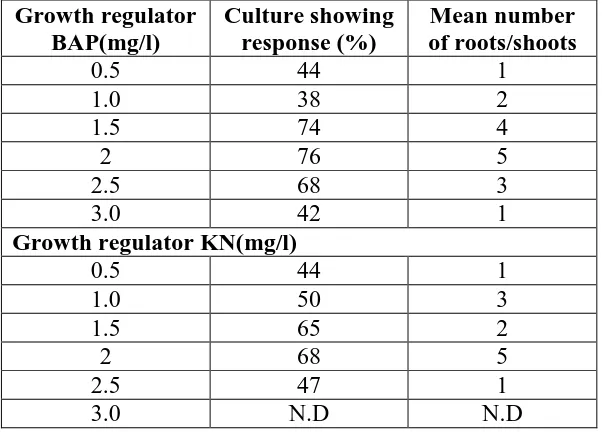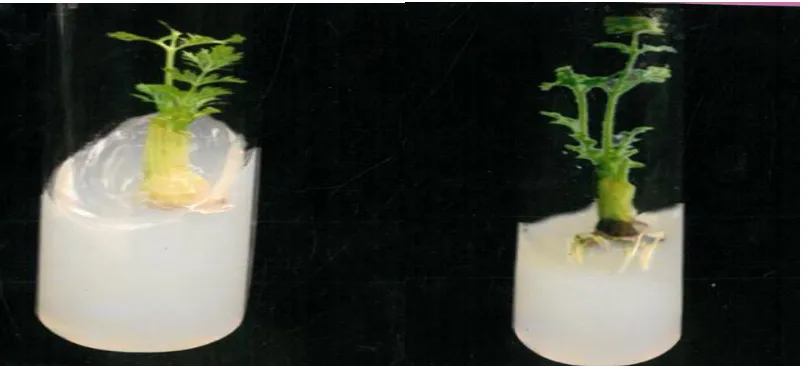IN VITRO MULTIPLICATION OF CORIANDRUM SATIVUM(L.) FROM
SHOOT TIP AND NODAL EXPLANTS
1
Porselvi. A*, 1Kalai Selvi. S and 2*Kulothungan. S
1
Research Department of Microbiology, Bharathidasan University Constituent College(W), Orathanadu,Tamilnadu.
2
PG & Research Department of Botany and Microbiology, A.V.V.M Sri Pushpam College, Poondi Tamilnadu.
ABSTRACT
Coriandrum sativum (L) (coriander) is a valuable medicinal plant. The plantlet regeneration protocol of this plant through nodal segments, were employed in microcloning and conservation. Standardization of
in vitro culture protocol for induction of shoot from shoot tip and nodal explants were used for shoot multiplication. Among these two explants, nodal produced maximum number of shoot buds. BAP (Benzyl Amino Purine) (2.0mg/l) was more effective than KN(Kinetin) (2.0mg/l) to produce multiple shoots. Rooting was best in half-strength MS medium with 1.0mg/l IBA. Almost 96% of the rooted shoots survived hardening under glass house and transferred to the field. The regenerated plants did not show any morphological change and variation in levels of secondary metabolites when compared with the mother stock.
KEYWORDS: Coriandrum sativum, Explant, MS medium, plant growth hormones.
INTRODUCTION
Coriander (Coriandrum sativum L.) which belongs to the family Apiaceae (Umbelliferae) is mainly cultivated from its seeds throughout the year (Mhemdi et al., 2011). India is the biggest producer, consumer and exporter of cori-ander in the world with an annual production of around three lakh tonnes. It is an annual, herbaceous plant which originated from the Mediterranean and Middle Eastern regions and known as medicinal plants. It contains an essential oil (0.03 to 2.6%) (Nadeem et al., 2013). All parts of this herb are in use as
Volume 4, Issue 8, 990-996. Research Article ISSN 2277– 7105
*Correspondence for
Author
Porselvi. A
Research Department of
Microbiology,
Bharathidasan University
Constituent College (W),
Orathanadu, Tamilnadu. Article Received on 26 May 2015,
flavoring agent and/or as traditional remedies for the treatment of different disorders in the folk medicine systems of different civilizations (Sahib et al., 2012). Coriander closely resembles flat leaf parsley. This resemblance makes many people confused between the two however, coriander has strong fragrance and parsley has mild fragrance. It grows best in dry climates however it can grow in any type of soil like light, well drained, moist, loamy soil, and light to heavy black soil (Verma et al., 2011). Its seeds are almost ovate, globular and have a mild, sweet, slight pungent like citrus flavor with a hint of sage. The most important constituents of its seeds are the essential oil and fatty oil. It is highly reputed ayurvedic medicinal plant commonly known as “Dhanya” in India. This plant is highly aromatic and has multiple uses in food and in other industries. Plants have played a critical role in maintaining human health and civilizing the quality of human life for thou-sands of years (Dhankar et al., 2011). Coriander has been reported to posses many pharmacological activities like antioxidant (Darughe et al., 2012), anti-diabetic (Eidi et al., 2012), anti-mutagenic (Cortes et al., 2004), anti-lipidemic (Sunil et al., 2012), anti-spasmodic (Alison et al., 1999). Moreover, coriander oil is used as an antimicrobial agent as it possesses broad spectrum antimicrobial activity (Silva et al., 2011). This oil can be encapsulated in alginates, chitosan etc. so as to enable isolation, protection, transport and release of its active components like vitamins, flavours, peptides, minerals, fatty acids, polyunsaturated fatty acids, antioxidants, enzymes and living cells (Cristian, 2013). The present study reports an efficient micro propagation system for regenerating a large number of plants directly from shoot tip and nodal explants of Coriandrum sativum which would form a strategy in the conservation of this important medicinal plant.
MATERIALS AND METHODS
The methods of plant tissue culture were the standard method as described in Plant Cell, Tissue and Organ Culture Fundamental Methods (Gamborg and Phillips, 2004). The plant materials selected for the present investigation was Coriandrum sativum (coriander) belong to the family umbellifereae. (Fig 1)
SOURCE OF EXPLANT
CULTURE MEDIUM
Nodal and shoot tip explants were used for direct regeneration on MS medium (Murashige and Skoog, 1962). The explants were first washed with tap water for about half an hour, followed by 2-4 drops of liquid soap for 10-20 min. After rinsing with tap water thoroughly, the explants were surface sterilized with 0.1% mercuric chloride solution for 2-3 min. This was followed by washing with sterile distilled water 3-4 times to remove the traces of HgCl2
solution. The shoot tip and nodal explants were inoculated by inserting their cut ends in the MS medium supplemented with 0.5, 1.0, 1.5, 2.0, 2.5 and 3 mg/l of BAP or KN individually include multiple shoots. The medium contained 3% (w/v) sucrose and solidified with 0.8% (w/v) agar. The pH of the medium was adjusted to 5.6 before gelling with agar and autoclaved at 121oC at 15 lb pressure for 20 min. The cultures were maintained at 25 ±2oC under the light intensity of 2000 lux provided by cool white fluorescent lamps. The shoots (5-6 cm long) bearing at least 4.5 internodes were excised from the mass of proliferated shoots and transferred to the rooting medium containing 0.5, 1.0, 1.5 and 2.0 mg/l of IBA. Rooted plantlets were transferred to polycups and PVC pots containing sterile soil and perlite (1:1) and covered with plastic bags to maintain 85 – 92% humidity. Subsequently, the plantlets were transferred to glass house after one month. The plantlets were planted in the soil after one month period of hardening. Experiments were set up in completely randomized block design. Ten cultures were raised for each treatment and all experiments were conducted thrice. Data on number of shoots, shoot length and number of roots and root length were determined.
RESULT AND DISCUSSION
number of shoot length was higher on the medium containing 2 mg/1. The higher concentration of KN inhibited the shoot formation from the shoot explants.
For root induction, plantlets were transferred to MS medium supplemented with different concentrations of IBA (0.5, 1.0, 1.5 and 2.0 mg/l) (Table 2). Number of roots per explant and root length were more on the medium containing IBA (1mg/1). The number of roots and root length decreased when the concentrations of IBA. The influence of IBA on enhanced root formation had also been reported in the case of Phyllanthus amarus (Nair and Seeni, 2001),
Centella asiatica (Banerjee, 1999), Phyllanthus caroliniensis (Catapan et al. 2000) and
Withania somnifera (Chandran et al. 2007).
Table 1: shows Mean number of shoots produced per shoot tip explants on multiplication media with different concentration of growth regulator BAP and KN after 4 weeks of culture
Growth regulator BAP(mg/l)
Culture showing response (%)
Mean number of roots/shoots
0.5 44 1
1.0 38 2
1.5 74 4
2 76 5
2.5 68 3
3.0 42 1
Growth regulator KN(mg/l)
0.5 44 1
1.0 50 3
1.5 65 2
2 68 5
2.5 47 1
3.0 N.D N.D
Table 2: Shows Mean number of roots produced per shoot tip explants on multiplication media with various concentration of IBA after 4 weeks of culture
Growth regulator IBA(mg/l)
Culture showing response (%)
Mean number of roots
0.5 54 2
1.0 72 8
1.5 68 4
2 58 2
2.5 52 4
3.0 N.D N.D
[image:4.595.148.449.348.564.2]Fig 1: Shows Habit of Coriandrum sativum (L.)
Fig 2: (a, b) Multiple shoots were induced in MS medium supplemented with 1.5mg/l BAP after two weeks.
[image:5.595.96.499.263.444.2] [image:5.595.98.502.506.689.2]CONCLUSION
In the present work has deciphered methods of improving in vitro propagation by developing a novel improved protocol highlighting efficient reproducible and reliable techniques for mass multiplication of a medicinally and economically important herb Coriandrum sativum.
Coriandrum sativum has a high morphogenic potential, and the explants readily responded to cytokinins in the culture medium and formed multiple shoot buds. Of the three growth regulators tried, we found BAP to be more suitable than KN as the former resulted in a quicker and better response than the latter. Nodal explants responded better than the shoot tip explants and gave maximum shoots on BAP (1.5 mg/1) with supplemented medium and Mean number of roots per explant (8) on the medium containing IBA (1 mg/1). Thus this proves that this present protocol could successfully be used for large scale clonal propagation without any seasonal constraint and also for conservation and commercial propagation of this medicinal plant in the Indian sub continent. The present study is a stepping stone for in vitro
production of required active principles of Coriandrum sativum. This protocol is novel because of its minimal requirements and cost effectiveness for propagation.
REFERENCE
1. Alison, M.G., Peter, R.F. Insulin releasing and insulin like activity of the traditional anti-diabetic plant Coriander sativum (coriander). British J. Nutr, 1999; 81(3): 203-209. 2. Banerjee, M and Shrivastava, S. In vitro regeneration of Jatropha curcas (Ratanjyot):
propects for biofuel production and medicines. Ind.J.Botanical Research, 2006; 2: 195-200.
3. Catapan, E., Otuki, M.K and Viana, A. M. 2000. In vitro culture of Phyllanthus caroliniensis. Plant Cell, Tissue and Organ Culture, 2000; 62: 195–202.
4. Chandran, C., Karthikeyan, K and Kulothungan, S. In vitro propagation of Withania somnifera (L.) Dunal. from shoot tip and nodal explants. Journal of Scientific Transactions in Environment and Tech Inovation, 2007; 1(1): 15-18.
5. Cortes-Eslava,J., Gomez-Arroyo,S., Villalobos-Pietrini, R. Antimutagenicity of coriander (Coriandrum sativum) juice on the mutagenesis produced by plant metabolites of aromatic amines. J. Toxicol. Lett, 2004; 153: 283-292.
7. Darughe, F., Barzegar, M., Sahari, M.A Antioxidant and antifungal activity of Coriander (Coriandrum sativum L.) essential oil in cake. Int. Food Res. J, 2012; 19(3): 1253-1260. 8. Dhankar, S., Kaur, R., Ruhil, S., Balhara, M., Dhankhar, S., Chhillar, A.K.2011. A review
on Justicia adhatoda A potential source of natural medicine. Afr. J. Plant Sci. 2011; 5(11): 620-627.
9. Gamborg, O.L and Phillips, G.C. Plant Cell, Tissue and Organ culture Fundamental methods, Narosa publishing House, New Delhi, India, 2004; 420.
10.Murashige, T and Skoog, F. A revised medium for rapid growth and bioassay with tobacco tissue cultures, Physiology and plants, 1962; 15: 472-497.
11.Ghanti, K.S., Govindaraju, B., Venugopal, R.B., Rao, S.R., Kaviraj, C.P and Jabeen, F.T.Z. High frequently shoot regeneration from Phyllanthus amarus Schum & Thonn.
Indian Journal of Boitechnology, 2004; 3: 103–107.
12. Mhemdi, H., Rodier, E., Kechaou, N., Fages, J. A supercritical tuneable process for the selective extraction of fats and essential oil from coriander seeds. J. Food Engg. 2011; 105(4): 609-616.
13.Nadeem, M., Anjum, F.M., Khan, M.I., Tehseen, S., El-Ghorab, A., Sultan, J.I. 2013. Nutritional and medicinal aspects of coriander (Coriandrum sativum L.) A review. Brit. Food J, 2013; 115(5): 743-755.
14.Nair, L.G and Seeni, S. Rapid in vitro multiplication and restoration of Celastrus paniculatus Willd.Subsps. paniculatus(Celastraceae), a medicinal woody climber.Journal of Experimental Biology, 2001; 39: 697-704.
15.Sahib, N.G., Anwar, F., Gilani, A.H., Hamid, A.A., Saari, A., Alkharfy K.M Coriander (Coriandrum sativum L.): A potential source of high-value components for functional foods and nutraceuticals- A Review. J. Phytother. Res, 2012; 27(9).
16.Silva, F., Ferreira, S., Queiroz, J.A., Fernanda, C.D. Coriander (Coriandrum sativum L.)
essential oilits antibacterial activity and mode of action evaluated by flow cytometry. J. Med. Microbiol. 2011; 60: 1479-1486.

